| Photographs greatly enrich our lives. Thanks to them
we have images of family, friends, important events in
our lives, favourite places, and some of our long-gone
ancestors. They bring back memories from the past and
allow us to see how local areas have changed with the
passing of time. Roger Taft has a wonderful collection
of old photographs, featuring trams, buses, and local
street scenes. They are an important archive that allows
us to look back into our parents' and grandparents'
world, which has changed almost beyond recognition.
Luckily for us, Roger has allowed me to include a number
of his marvellous photographs in this section, which I
hope you will enjoy. Some take us back to the early years of the twentieth century, and others take us
to the 1920s, the 1930s, and through to the 1960s.
The remarkable collection allows us to look back at
everyday life in a long-gone world. |
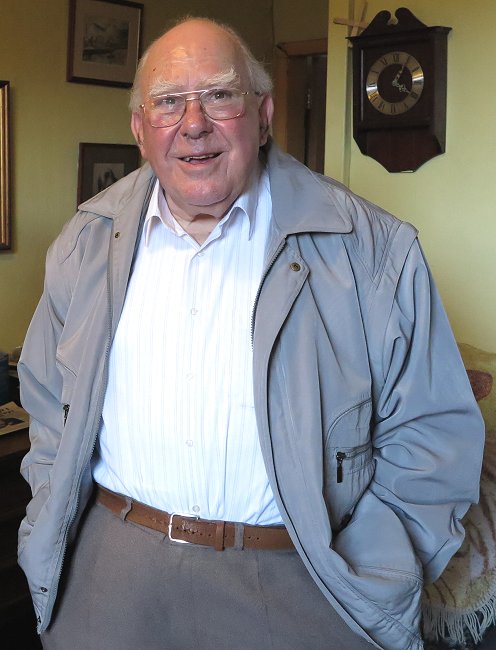
Roger Taft. |
|
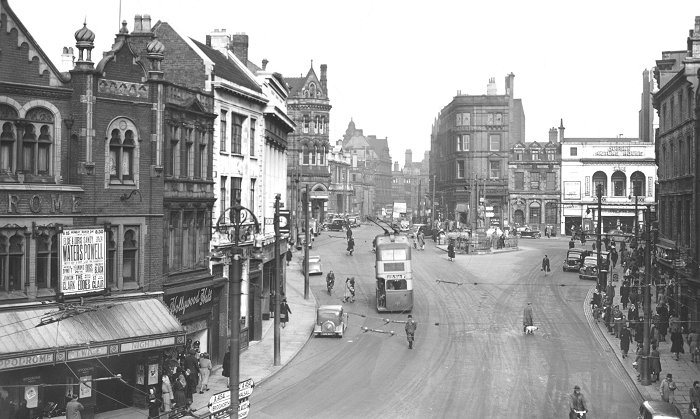
A fine view of Queen Square, taken in March 1952.
From the Roger Taft collection. |
|

An earlier view of Queen
Square, as seen during a busy day in the 1920s.
From the Roger Taft collection. |
|
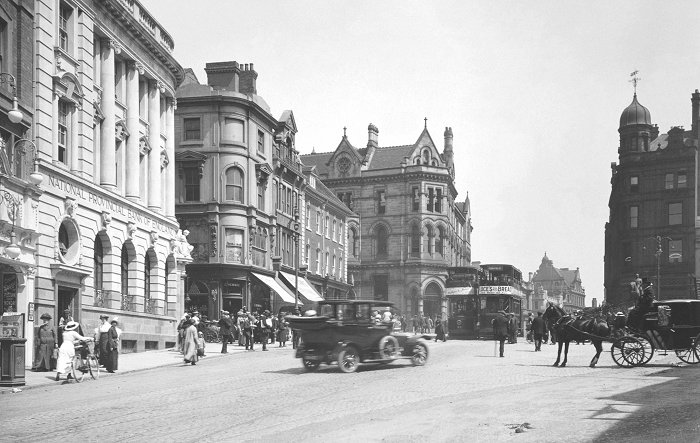
An even earlier view of
Queen Square, just before the First World War. From the Roger Taft
collection. |
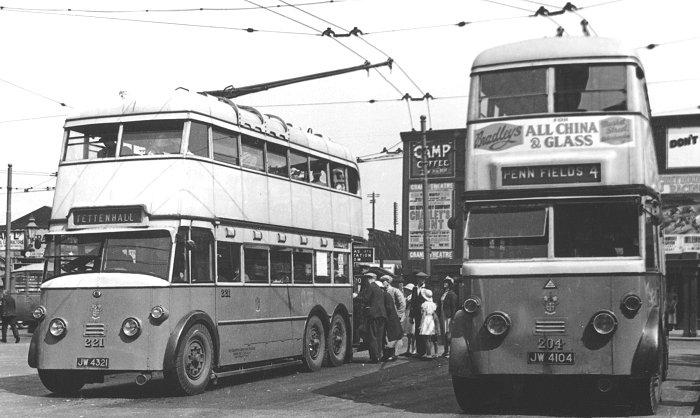
Victoria Square was an
important terminus for local buses. On the
left is a number 1, which would soon be on
its way to Tettenhall. On the right is a
number 4, bound for Penn Fields. Victoria
Square disappeared due to the building of
Ring Road St Davids in the mid 1980s and the
surrounding redevelopments including the new
bus station. Number 221 is Guy BTX, built in
1934 and withdrawn in 1946. Number 204 is a Sunbeam MS3 with a
Metro-Cammell body, built in 1934 and withdrawn in 1945. From the Roger Taft
collection. |

A Wolverhampton
Corporation trolleybus on the number 2
route, from Whitmore Reans to Darlaston
via Bilston, parked in Victoria Square near the top of Fryer Street.
It is about to turn right to the Darlaston bus stop that was between Railway Drive
and Horseley Fields. The bus is a 1949
Guy BT with a Park Royal body. It was
withdrawn in 1964. From the Roger Taft
collection. |
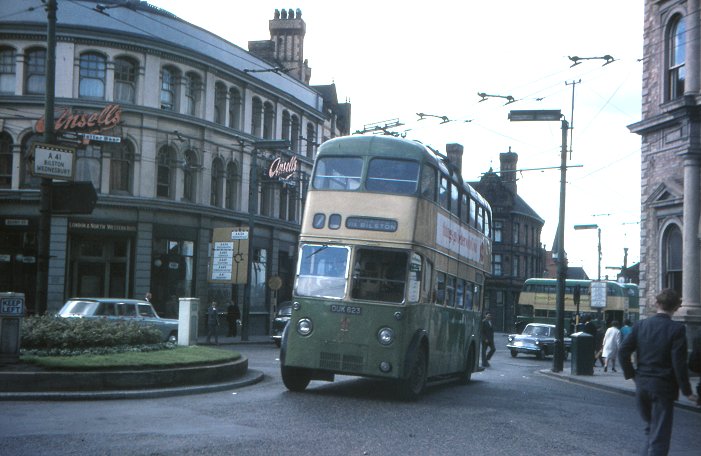
A trolleybus
leaving Victoria Square on its way
to Bilston and Darlaston. It is a
Sunbeam F4 with a Park Royal body,
built in 1950, and withdrawn in
1961. From the Roger Taft collection. |
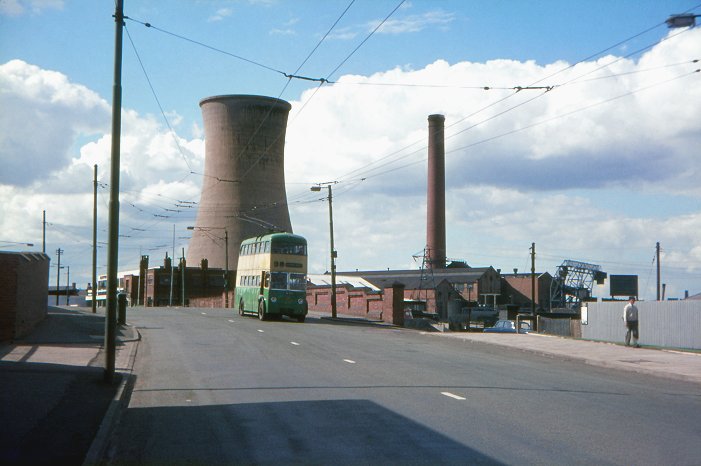
Another
trolleybus on its way to
Darlaston via Bilston, with the
old Commercial Road power
station in the background.
From the Roger Taft collection. |
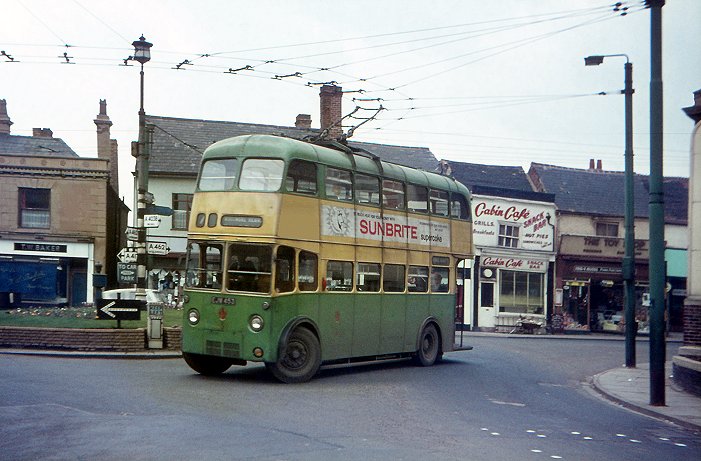
A
trolleybus at the terminus
in the Bull Stake at
Darlaston. It is about to
return to Wolverhampton and
Whitmore Reans. From the Roger Taft
collection. |
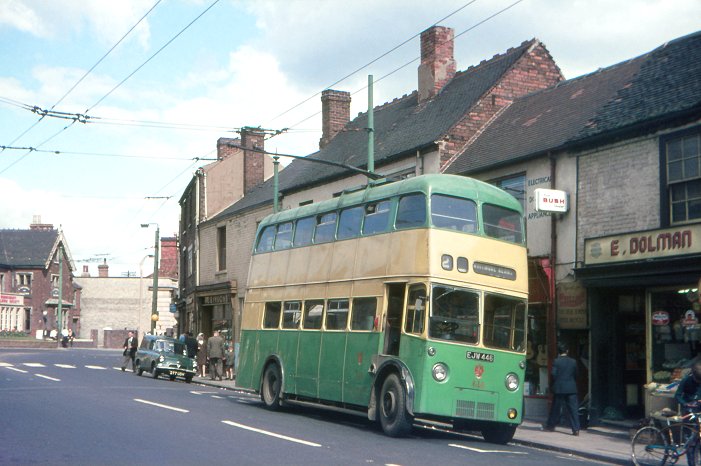
A
trolleybus at the bus
stop for Wolverhampton,
in Pinfold Street
Darlaston. It is a
Sunbeam W4 that was
built in 1948. It
originally had a Park
Royal body, but was
re-bodied by Roe in
1960, and was withdrawn
in 1967. From the Roger Taft
collection. |

Another trolleybus
on the number 2
route, seen at
Catherine's Cross in
Darlaston whilst on
its way to Bilston
and Wolverhampton.
Like the bus in the
previous photo, it is a
Sunbeam W4 that was
re-bodied by Roe in
1960, and withdrawn
in 1967. From the Roger Taft
collection. |
|

A trolleybus on
the Darlaston
route, seen at
Moxley, on its
way to
Wolverhampton.
From the Roger Taft
collection. |
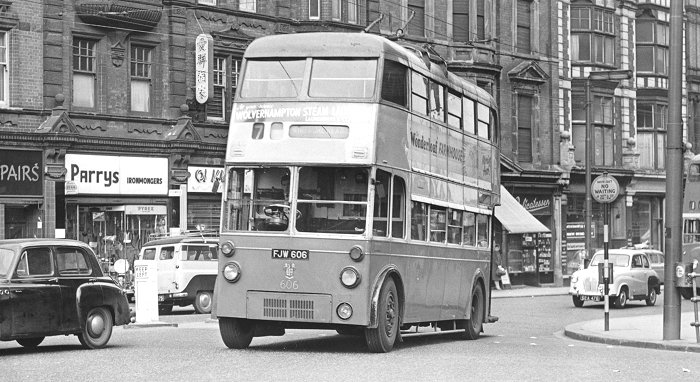
A
photo
taken
in
1960
showing
a
Guy
BT
trolleybus
in
Lichfield
Street
on
the
number
7
route,
on
its
way
to
Whitmore
Reans.
To
the
left
of
the
bus
is
Edward
Parry's
wonderful
ironmongers
shop,
which
sadly
closed
in
the
early
1990s.
From
the Roger Taft
collection. |
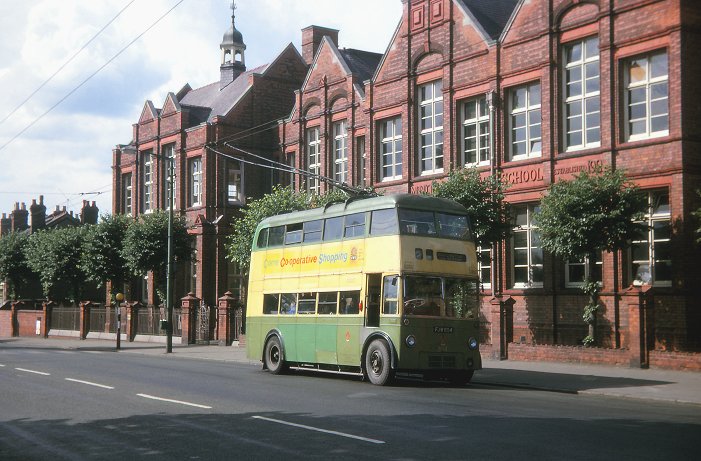
A final
view of
a
trolleybus
on the
Whitmore
Reans to
Darlaston
route.
The bus,
a 1950
Guy BT
with a
Park
Royal
body is
seen
outside
the
Municipal
Grammar
School
in
Newhampton
Road
East.
From the Roger Taft
collection. |

A view
of
trolleybuses
in Victoria
Square, at
the top of
Fryer
Street in
about 1936. In
the
background
is the Sir
Tatton Sykes
pub. The bus
on the left,
a number 4
bound for
Penn Fields
is a Sunbeam
MS2 with a
Park Royal
body, built
in 1935 and
withdrawn in
1949. The
bus on the
right is a
number 1
bound for
Tettenhall.
It is a
Sunbeam MS2 with a
Metro-Cammell
body. It was
built in
1934, and
withdrawn in
1948.
From the Roger Taft
collection. |
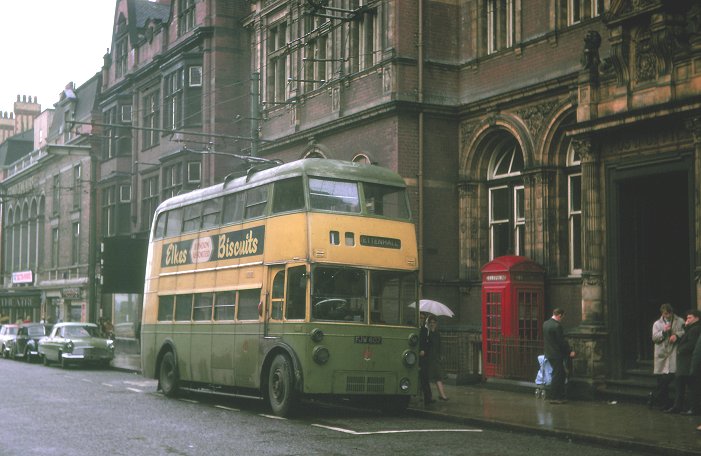
A trolleybus on the number 1 service to
Tettenhall, at the bus stop outside the old post office in Lichfield
Street. It is a Guy BT with a Park Royal body, built in 1949, and
withdrawn in 1964. From the Roger Taft collection. |
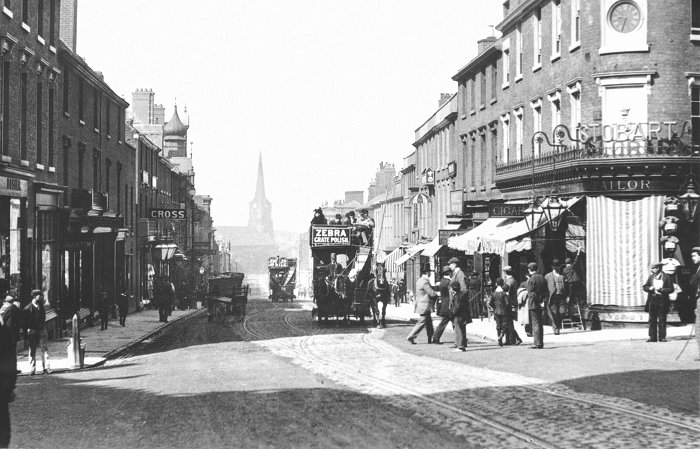
A view of Darlington Street in about 1900 with
two horse-drawn trams. The one in the distance, on its way to
Newbridge is number 22, built in 1892. The nearest tram, returning
to Queen Square has three horses, the third being added to assist
the tram on its climb up the hill. From the Roger Taft collection. |
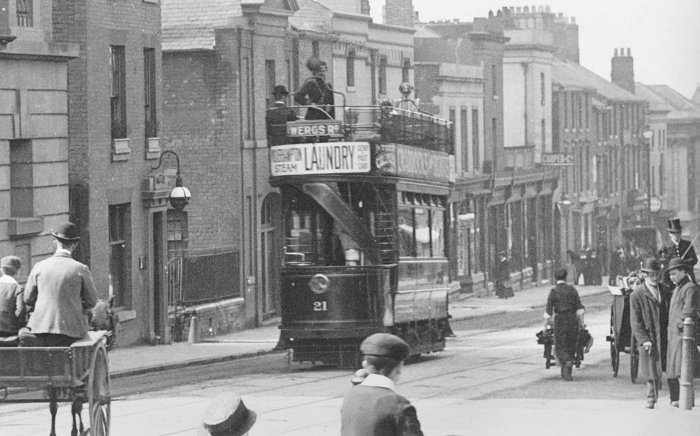
Lorain tram number 21 in Darlington Street, on
its way to Tettenhall. It was built by Brush in 1902. It had just
passed the Methodist Church which is on the left, and is passing the
shops that were demolished in the 1970s to make way for Fold Street
Car Park. From the Roger Taft collection. |
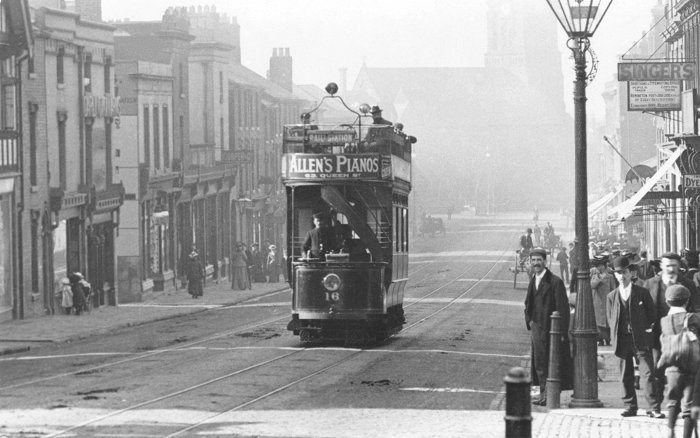
Lorain tram number 16 on its way back to town
from Tettenhall. Like the tram in the previous photo it was built by
Brush in 1902. Singers, listed on the sign on the right, had a typing and shorthand
office. They did all kinds of typing and copying, and held classes
in typing and shorthand. From the Roger Taft collection. |
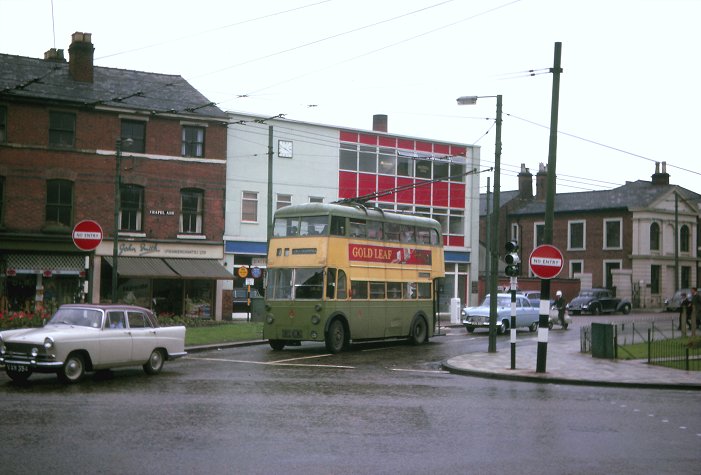
A trolleybus on the Tettenhall service enters Chapel Ash from Darlington Street. It is passing John Smith's shop. He was a fish merchant. From the Roger Taft collection. |

Another trolleybus on the Tettenhall route waits at the traffic lights at the bottom of Chapel Ash. It is a Sunbeam F4 with a Park Royal body, built in 1949, and withdrawn in 1963. From the Roger Taft collection. |
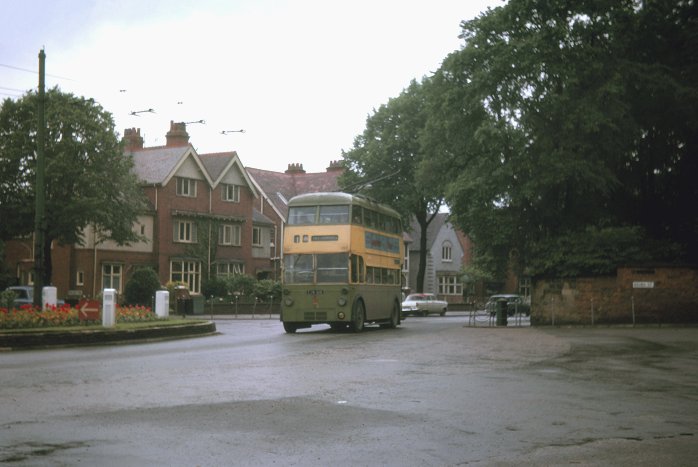
A 1949 Guy BT trolleybus with a Park Royal
body passes Albert Road as it journeys along Tettenhall Road towards
town. From the Roger Taft collection. |
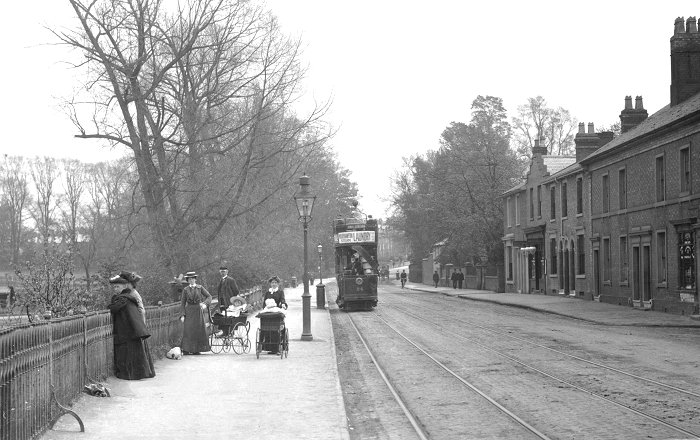
A wonderful view of Newbridge looking towards town. The Lorain tram is number 24. From the Roger Taft collection. |
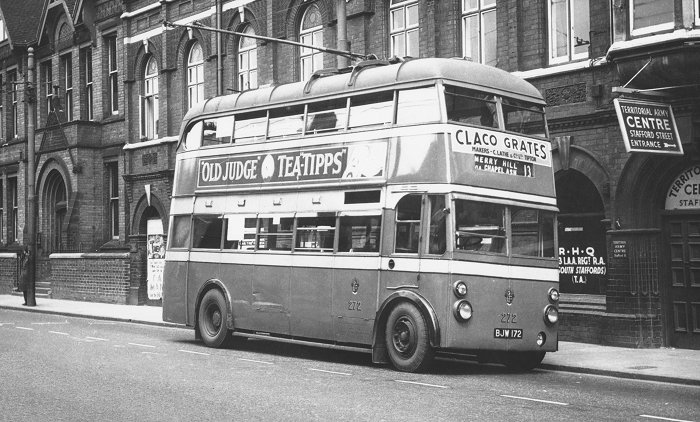
A trolleybus waits at the bus stop in Stafford
Street next to the Territorial Army Centre, which is now apartments.
It is on the number 13 route to Merry Hill via Chapel Ash. The bus
is a 1938 Sunbeam MF2 with a Park Royal body. It was withdrawn in
1949. From the Roger Taft collection. |
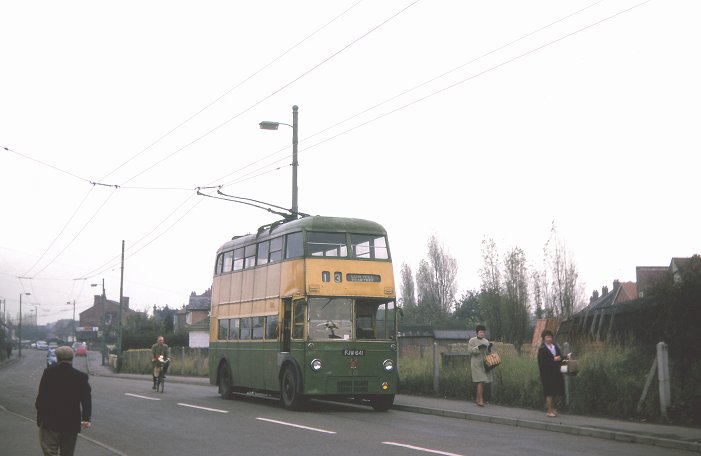
Another trolleybus on the number 13 route, at the Merry Hill bus stop at the end of Trysull Road. It is a 1949 Guy BT with a Park Royal body, withdrawn in 1964. From the Roger Taft collection. |
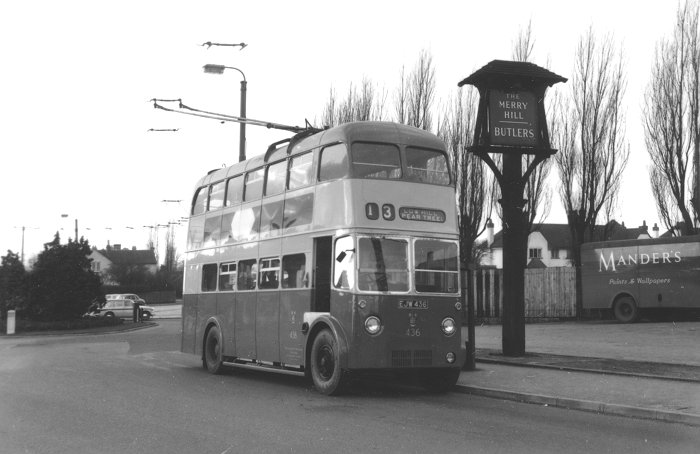
Another view of a trolleybus at Merry Hill. It is standing at the bus stop beside the Merry Hill pub, before returning to Wolverhampton. It is a 1948 Sunbeam W4 which initially had a Park Royal body, and was re-bodied by Roe in 1960. It was withdrawn in 1967. From the Roger Taft collection. |
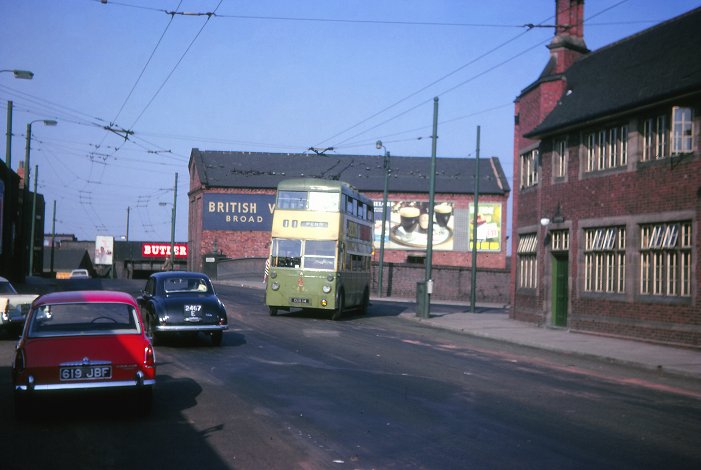
A trolleybus on the number 11 route to Penn,
turns into Broad Street from Railway Street. It is a 1945 Sunbeam W4
with a Park Royal body, that was withdrawn in 1963. From the Roger Taft
collection. |
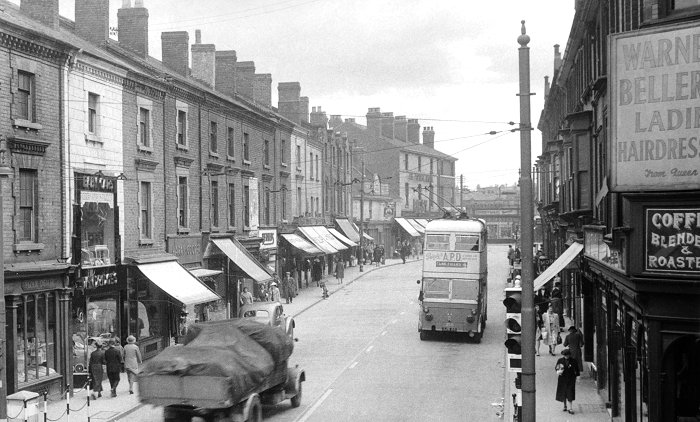
A wartime view of a trolleybus on the number 4
route from Penn Fields, as it travels along Worcester Street before
entering Victoria Street. It is a 1937 Guy BT which was withdrawn in
1949. The view has hardly changed, other than Berryman's shoe shop
at the bottom of Temple Street, that is long gone. From the Roger Taft
collection. |
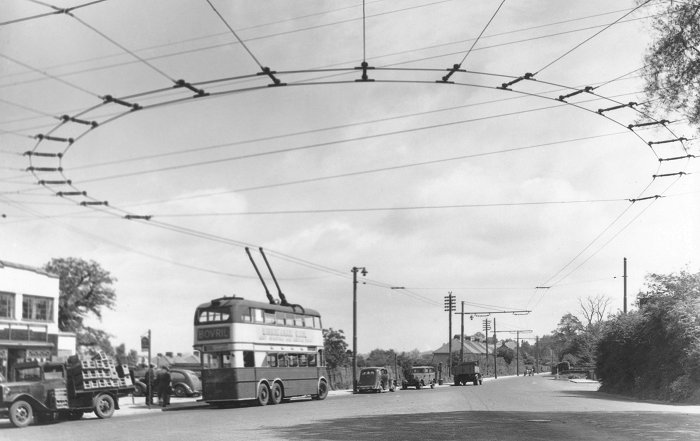
Penn terminus on Penn Road, at the corner of Springhill Lane, before the shops were built. From the Roger Taft collection. |
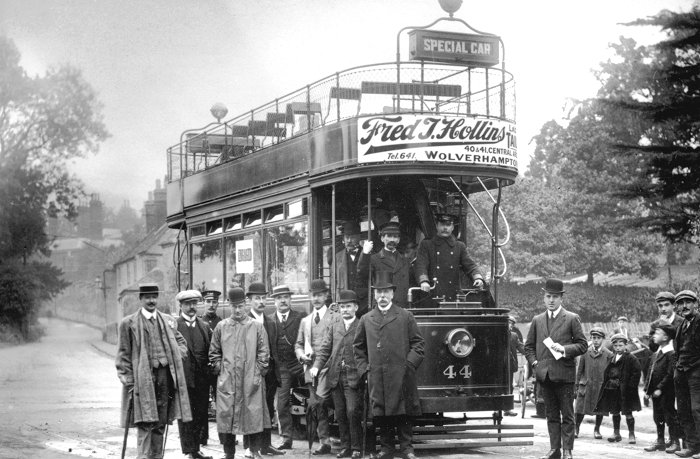
A Lorain tram at the Stubbs Road terminus in Penn Fields on 10th September, 1909, the first day of operation. The party consists of councillors and tramway officials. In the distance is Penn Road, and a very different looking Rookery Lane. The tram, number 44 was built in 1908 by the United Electric Car Company Limited. From the Roger Taft collection. |
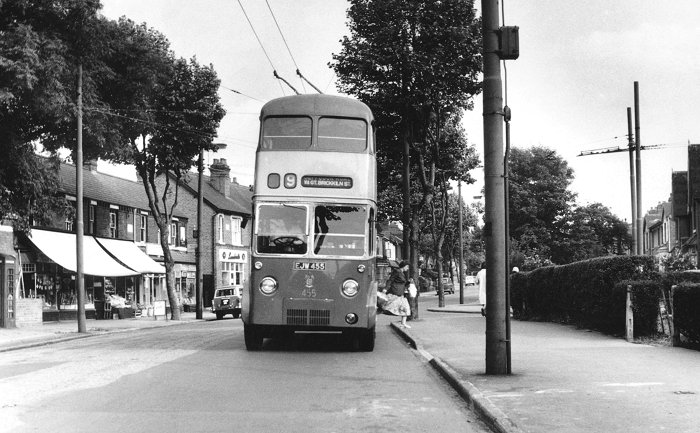
A trolleybus on the number 9 route seen in
Jeffcock Road. It is a 1948 Sunbeam W4 with a Roe body, which it
received in 1960. It was withdrawn in 1967. From the Roger Taft
collection. |
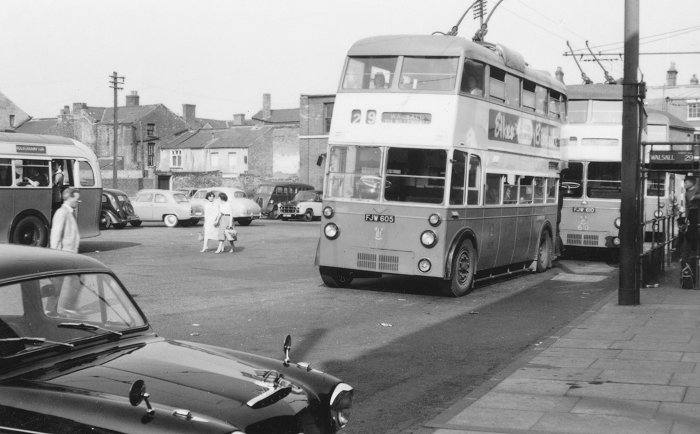
Trolley buses at the Walsall bus terminus in St. James' Square. The trolleybus in front, on the number 29 route, about to depart for Walsall is a 1949 Guy BT with a Park Royal body. It was withdrawn in 1964. From the Roger Taft collection. |
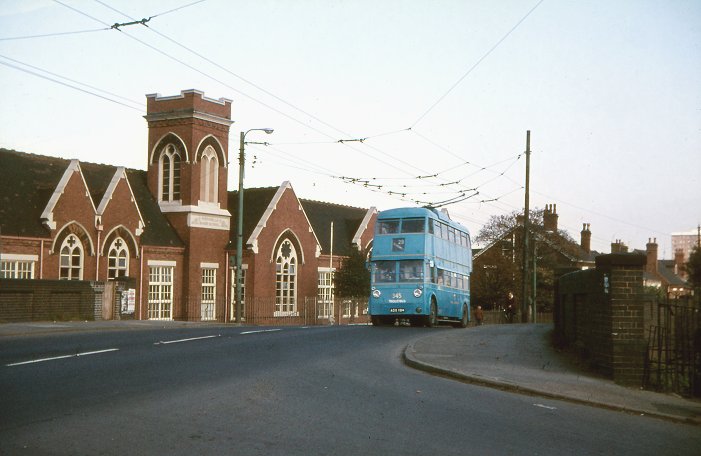
A Walsall Corporation trolleybus passes
Portobello School, as it crosses the railway bridge, on its way to
Wolverhampton. From the Roger Taft collection. |
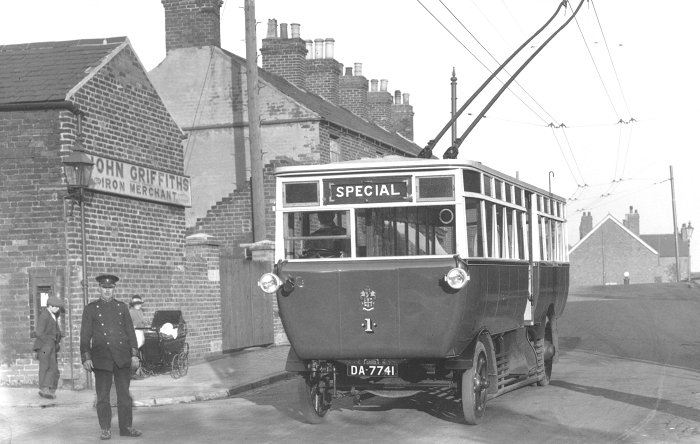
Trolley bus number 1 in Wednesfield Road, looking towards the
canal bridge. The trolley bus route to Wednesfield from Broad
Street, began operation on 29th October, 1923. It is a Tilling
Stevens, with a Dodson 40 seat body. From the Roger Taft collection. |
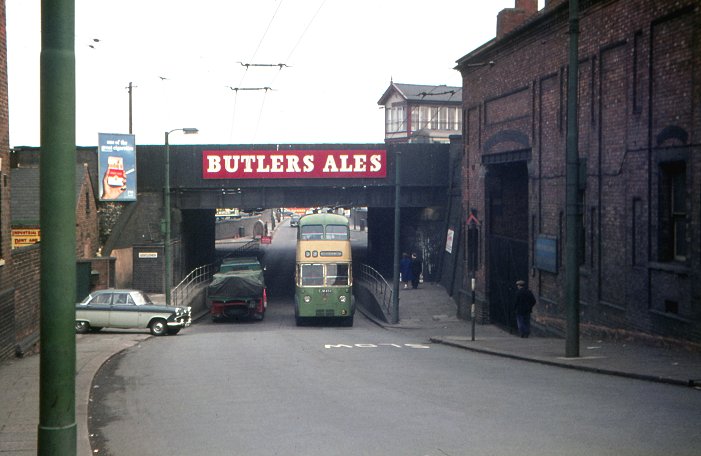
A Sunbeam W4 trolleybus with a Park Royal body, passes beneath Broad Street railway bridge on its way to the town centre. From the Roger Taft collection. |

A 1949 Sunbeam F4 trolleybus with a Park Royal body stands in Cleveland Road next to the old Newmarket Hotel. All of the buildings have been demolished in the last few years. From the Roger Taft collection. |
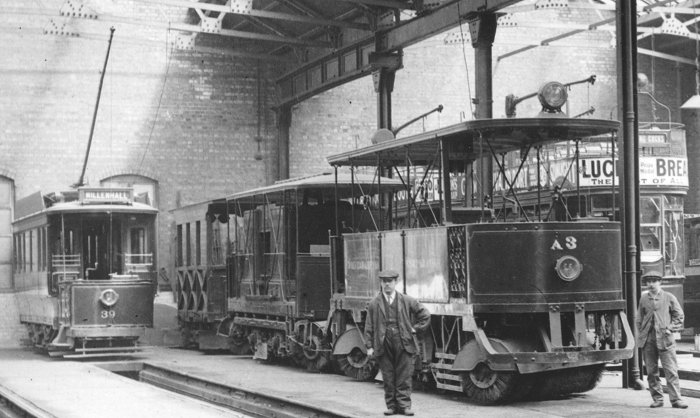
A corner of the Cleveland Road Tram Depot,
with a single decker from 1905, and track cleaning vehicles. From
the Roger Taft collection. |
|
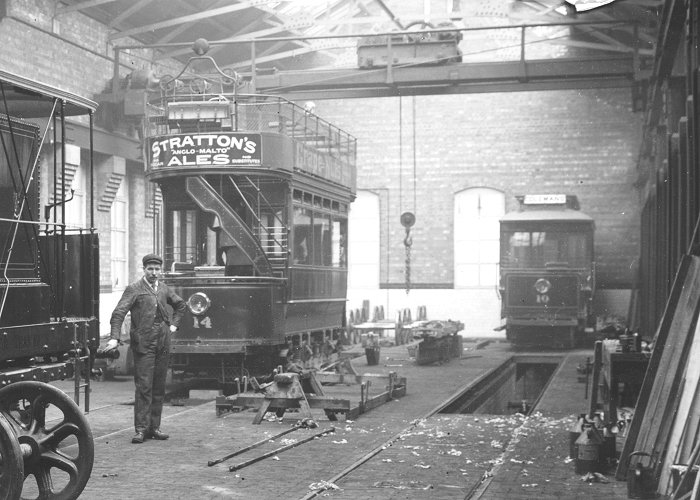
Another view inside the tram depot with Lorain
trams number 14 and 10. From the Roger Taft collection. |
|
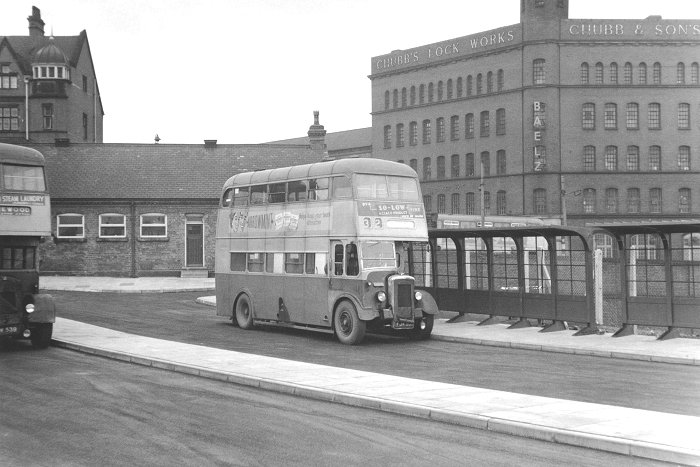
Buses standing in the old bus station at the top of Railway Street, next to Railway Drive. From the Roger Taft collection.
|
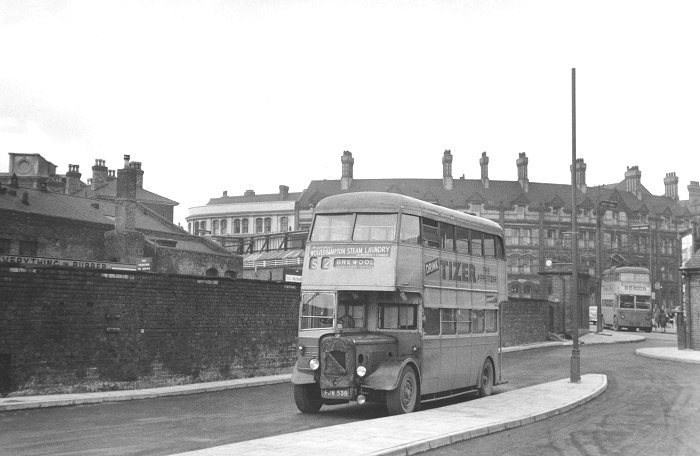
A Brewood bus stands in the old bus station at the top of Railway Street, next to Railway Drive. From the Roger Taft collection. |
|
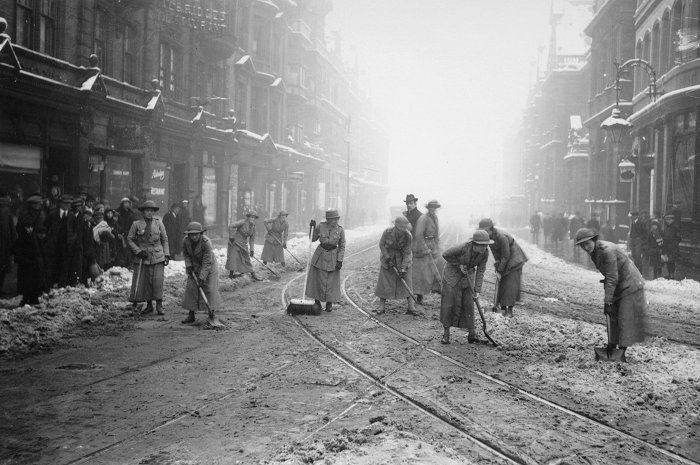
Women volunteers clearing snow in Lichfield Street, during the First
World War. From the Roger Taft collection. |

A trolleybus turns into Garrick Street on its way to the Fighting Cocks, Sedgley, and Dudley. It has just left the terminus in Bilston Street. On the left is the old Garricks Head pub. From the Roger Taft collection. |

A tram from Dudley approaches as it travels along
Snow Hill. The ornate Agricultural Hall Cinema can be seen on the corner of Cleveland Road. From the Roger Taft collection. |
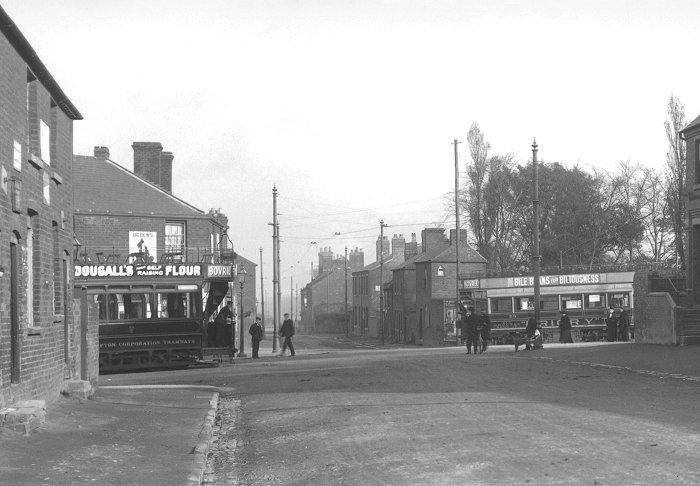
A view of the Fighting Cocks in the early years of the 20th century.
On the left is a Wolverhampton Corporation Lorain tram at its
terminus. The tram on the right is a Wolverhampton District Electic
Tramways Limited vehicle,
on its way from Dudley to Bilston. It is about to turn into
Parkfield Road. From the Roger Taft collection. |
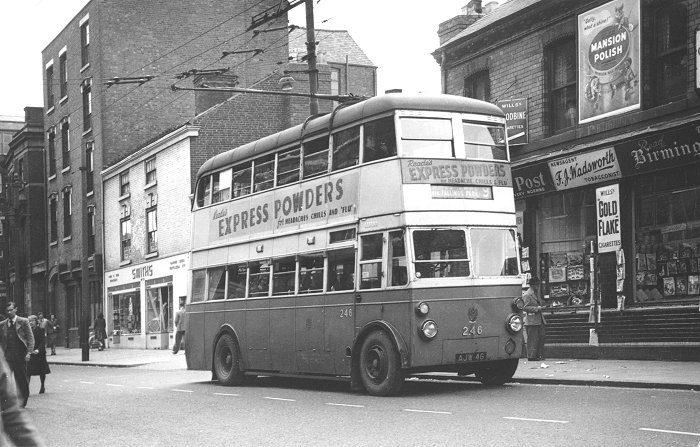
Stafford Street in the late 1940s before the buildings that are now part
of the university were built. On the
extreme left is the George Hotel. The tall building next door was
Wilcox’s, the rag, bone, and scrap metal
merchants. The trolleybus is a 1937 Sunbeam MF2. From the Roger Taft
collection. |
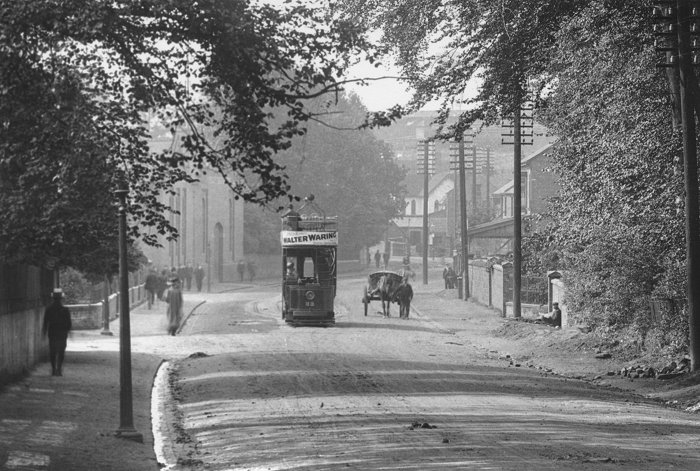
Bushbury tram terminus on Stafford Road. The large building in the
distance on the
left is the old E.C.C. factory. From the Roger Taft collection. |
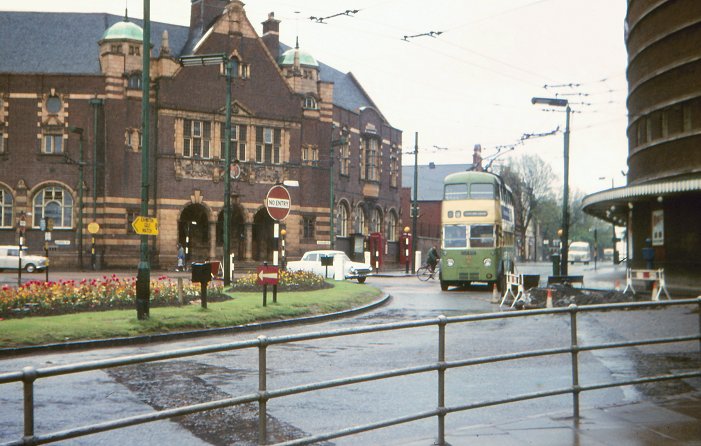
A trolleybus approaches Snow Hill from Cleveland Road in the 1960s. The Central Library on the left has changed very little, but the Gaumont Cinema on the right closed on 10th November, 1973 and was demolished in 1974. From the Roger Taft collection. |
 |
Return to
the
previous page |
|